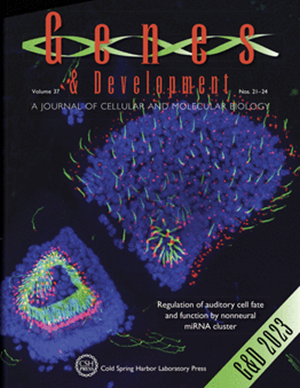The Rbfox1/LASR complex controls alternative pre-mRNA splicing by recognition of multipart RNA regulatory modules
IF 7.7
1区 生物学
Q1 CELL BIOLOGY
引用次数: 0
Abstract
The Rbfox proteins regulate alternative pre-mRNA splicing by binding to the RNA element GCAUG. In the nucleus, most of Rbfox is bound to the large assembly of splicing regulators (LASR), a complex of RNA-binding proteins that recognize additional RNA motifs. However, it remains unclear how the different subunits of the Rbfox/LASR complex act together to bind RNA and regulate splicing. We used a nuclease protection assay to map the transcriptome-wide footprints of Rbfox1/LASR on nascent cellular RNA. In addition to GCAUG, Rbfox1/LASR binds RNA motifs for LASR subunits hnRNPs M, H/F, and C and Matrin3. These elements are often arranged in tandem, forming multipart modules of RNA motifs. To distinguish contact sites of Rbfox1 from the LASR subunits, we analyzed a mutant Rbfox1(F125A) that has lost RNA binding but remains associated with LASR. Rbfox1(F125A)/LASR complexes no longer interact with GCAUG but retain binding to RNA elements for LASR. Splicing analyses reveal that in addition to activating exons through adjacent GCAUG elements, Rbfox can also stimulate exons near binding sites for LASR subunits. Minigene experiments demonstrate that these diverse elements produce a combined regulatory effect on a target exon. These findings illuminate how a complex of RNA-binding proteins can decode combinatorial splicing regulatory signals by recognizing groups of tandem RNA elements.Rbfox1/LASR复合体通过识别多部分RNA调控模块来控制备选的pre-mRNA剪接
Rbfox蛋白通过结合RNA元件GCAUG来调节备选的pre-mRNA剪接。在细胞核中,大多数Rbfox与剪接调节因子大组装体(LASR)结合,LASR是一种RNA结合蛋白复合物,可识别额外的RNA基序。然而,目前尚不清楚Rbfox/LASR复合体的不同亚基如何共同作用以结合RNA并调节剪接。我们使用核酸酶保护实验来绘制Rbfox1/LASR在新生细胞RNA上的转录组足迹。除了GCAUG外,Rbfox1/LASR还结合LASR亚基hnRNPs M、H/F、C和Matrin3的RNA基序。这些元素通常串联排列,形成RNA基序的多部分模块。为了区分Rbfox1与LASR亚基的接触位点,我们分析了Rbfox1突变体(F125A),该突变体已失去RNA结合,但仍与LASR相关。Rbfox1(F125A)/LASR复合物不再与GCAUG相互作用,但保留与LASR RNA元件的结合。剪接分析表明,除了通过邻近的GCAUG元件激活外显子外,Rbfox还可以刺激LASR亚基结合位点附近的外显子。迷你基因实验表明,这些不同的元件对目标外显子产生联合调控作用。这些发现阐明了RNA结合蛋白复合物如何通过识别串联RNA元件组来解码组合剪接调节信号。
本文章由计算机程序翻译,如有差异,请以英文原文为准。
求助全文
约1分钟内获得全文
求助全文
来源期刊

Genes & development
生物-发育生物学
CiteScore
17.50
自引率
1.90%
发文量
71
审稿时长
3-6 weeks
期刊介绍:
Genes & Development is a research journal published in association with The Genetics Society. It publishes high-quality research papers in the areas of molecular biology, molecular genetics, and related fields. The journal features various research formats including Research papers, short Research Communications, and Resource/Methodology papers.
Genes & Development has gained recognition and is considered as one of the Top Five Research Journals in the field of Molecular Biology and Genetics. It has an impressive Impact Factor of 12.89. The journal is ranked #2 among Developmental Biology research journals, #5 in Genetics and Heredity, and is among the Top 20 in Cell Biology (according to ISI Journal Citation Reports®, 2021).
 求助内容:
求助内容: 应助结果提醒方式:
应助结果提醒方式:


